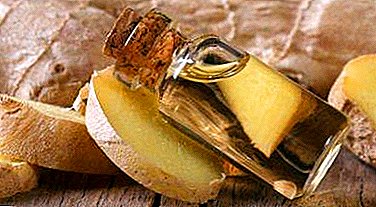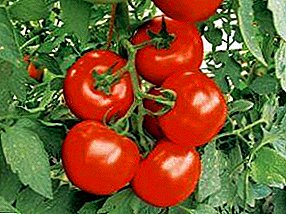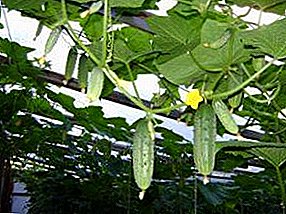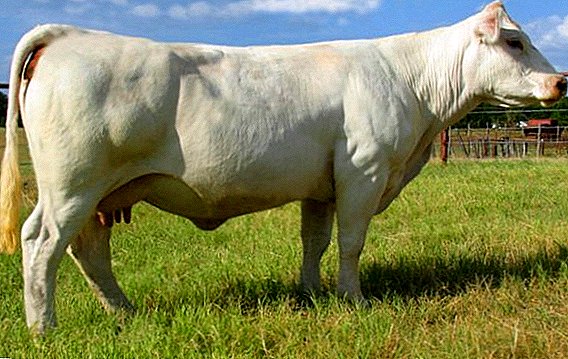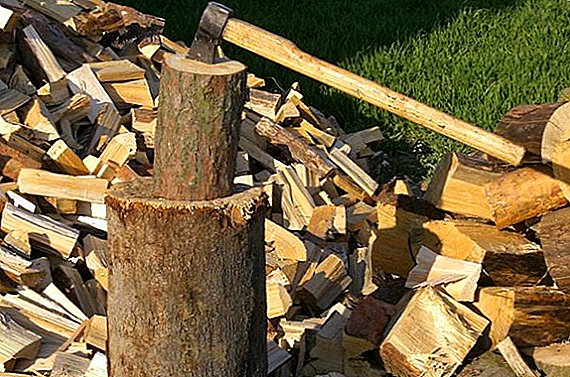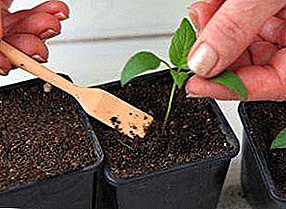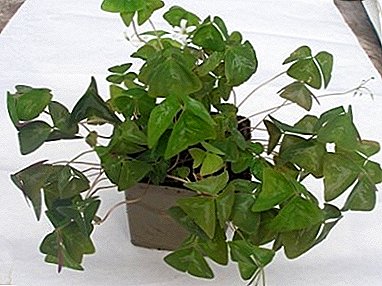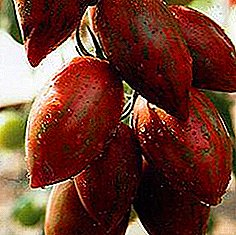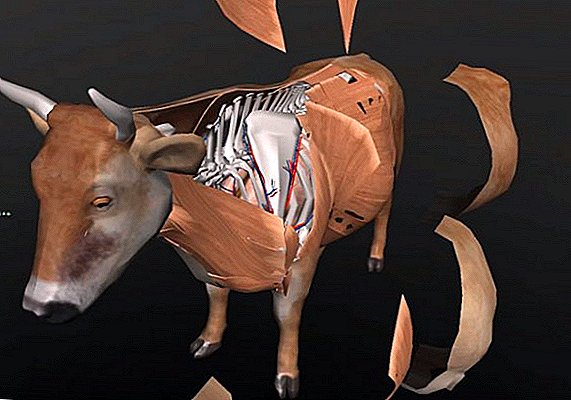 The cow is one of the most important domestic animals - meat and dairy products from it are on our table almost daily.
The cow is one of the most important domestic animals - meat and dairy products from it are on our table almost daily.
Let us consider in more detail the anatomy and physiological features of this animal.
Head
The largest pet has a large head, which is located on the same axis as the spine. Pronounced facial features are the main data of this representative of cattle. 
Skull
A large skull, connected via the cervical spine to the skeleton of an animal, is one of the means of protection. The cow, unlike other large hoofed mammals, does not throw off the horns. The structure of the skull is divided into brain and facial parts.
The strong bones of this part of the skeleton can withstand strong exposure. In addition to strong bones, the head of the animal has powerful occipital muscles, which helps for a long time to be on the pasture with its head down.
Important! The calf's skull has equally developed facial and brain parts. With age, the facial part develops much more noticeably, and the face becomes larger than the rest of the skull.
Eyes
The eyes of the cow are very expressive, because this organ consists of three shells at once - reticular, vascular and fibrous. The pupil is located in the iris, which belongs to the choroid.
Cows have long and hard eyelashes, due to which they are called "burenkami". They help the animal to distinguish the length of blades of grass and to avoid eye injury on various tall plants.
The structure of the eye does not allow these pets to see the colors - they normally distinguish only white, and worst of all they see green and red. Cows also see the image on an enlarged scale, which makes their movements awkward.
Find out what is fever and how to cure it.
Teeth
This pet has a complex teeth system that changes as it matures. Initially, the calf has 20 milk teeth, which are replaced by indigenous ones within a year and a half. An adult cow has 32 teeth, among which there are no upper incisors.
Because of their absence, the animal tweaks the grass in a special way - it captures a bunch of grass with its lips and tongue into the mouth and presses it to the lower teeth. After that, the grass is pulled out with a sharp movement of the head.
Important! Thus, unlike sheep or goats, cows do not injure the roots of plants, therefore the grass is always green on their pastures.The adult has 24 molar teeth with a flat structure and 8 incisors. The animal has no canines, but its jaw muscles are very strong. The immobility of the upper jaw is compensated by the activity of the lower jaw, which is capable of making circular grinding movements.

Ears
The hearing of a cow is simply unique, as this animal memorizes musical compositions and is able to respond to a remembered melody.
The hearing aid of a cow consists of three parts:
- internal;
- medium - contains the eardrum;
- external - consists of a large number of cartilage, giving the body mobility.
Check out the criteria for choosing a dairy cow.
Skeleton
The skeleton of this representative of cattle is an example for research beginner physicians. It has large strong bones, and their consideration helps in understanding the structure of the body and the musculoskeletal system of animals. 
Spine
The spine of a cow is divided into five sections:
- cervical - 7 vertebrae from the skull to the chest;
- Thoracic - 13 vertebrae, which are consistent with the ribs and are mobile in the lower part near the lungs;
- lumbar - 6 vertebrae;
- sacral - 5 vertebrae;
- caudal - up to 20 vertebrae.
Find out how much a cow weighs depending on the breed.

Limbs
The forelegs rest on the thoracic spine, therefore they are called accordingly the thoracic. The hind limbs are called pelvic. There are also auxiliary bones, through which the limbs are connected to the skeleton.
For the front bones it is the shoulder blades, shoulders, forearms, hands, and for the back bones it is a system of hip bones, thigh, shin and foot.
Did you know? When the cows are happy, they run and jump from the feelings flooding them.All four limbs of a cow end in hooves - two forked fingers with rudiments of two more that hang from behind.
Video: skeleton foot KRS
Internal organs and systems
A large and powerful animal must be strong and resilient. A cow is just that, and all internal organs and systems help her in this.
Muscular
The musculoskeletal system of the animal at birth is almost 80% of the mass. When growing up, this figure decreases to 60-70% - this means that such a powerful skeleton needs to be moved with serious muscle mass, which makes up almost 50% of the weight of an adult individual.
Learn more about cow diseases.
The musculature of a large bull consists of almost 250 different muscles, which often work with the opposite effort — translational or removing, flexing or extending. Due to the quality work of the whole complex - the external skeletal muscles and the internal system of smooth muscles - all organs and body systems operate without interruption. 
Nervous
The nervous system of the animal includes the senses, through which the cow sees, hears and feels the world around it. All the data obtained are delivered to the brain, where they are processed and conclusions are drawn about the need and type of reaction to the information received. Each part of the brain is responsible for a specific reaction, controlled by the fibers of the spinal tract.
Learn how to wean a cow butt.High-quality work of the internal organs determines a healthy and productive animal, so you should pay close attention to proper nutrition and a good psychological atmosphere when growing adults.

Respiratory
A large volume of internal cavities in the chest is the respiratory system, through which the body is gas exchange. Due to the size of the animal, its respiratory system is very large and developed.
Did you know? The right lung of cattle is larger than the left because of the placement of a large heart in the chest. The left organ can be practically divided by the location of the heart in two parts.The weight of the lung in a cow reaches 3.55 kg, in a bull - 4.8 kg, and respiration rate is an important factor for the diagnosis of various diseases.

Cardiovascular
The heart of a healthy cow is able to pump several tons of blood through itself per day. This is sufficient to ensure continuous movement of the main fluid in the body.
In the circulatory system there is a constant movement of blood and lymph, which positively affects the hormonal regulation and the immune system.
Learn how to measure the temperature of a cow, how to take a biochemical blood test from a cow.High-quality work of the heart helps to transfer antibodies and hormones, and also contributes to the provision of body cells with water, oxygen, nutrients.
The four-chamber heart of cattle is divided into two parts, each of which has an atrium and a ventricle. Thin-walled atria receive blood from the lungs and deliver fluid to the left atrium, where it is squeezed out of the heart chambers. 
Digestive
The digestive system of a cow has a complex device that allows you to get the necessary nutrients, even from scarce and hard feed. Eaten "quickly" food regurgitates from the stomach into the oral cavity for further chewing, and then swallowed again in the already digestible form.
Oral cavity. Lips, teeth and tongue seize vegetable foods, which are then crushed with the help of teeth and a dental plate located above the lower incisors. The size of the upper jaw is larger than the lower one, and the animal benefits from it by moving food from one side of the mouth to the other.
A large number of salivary glands are located in the oral cavity, which help with the grinding of food, significantly moisturizing it. Through the esophagus, the mass of food moves into the stomach, which has a unique structure, from where, over time, it springs up to "dozhivyvanie".
Learn how to feed a cow, what to do when a cow is poisoned, than to feed dry cows.The cow's stomach has a complex structure and functionality - this body consists of several departments:
- net department (consists of a grid and a hem);
- book;
- abomasum.

Actually, the abomasum is a real stomach with the secretion of gastric juice, and the previous parts are considered only an expansion of the esophagus.
Food in a portion form enters the small intestine from the abomasum. The bile and pancreatic juice digest food, and the released substances are absorbed into the blood. The small intestine of an adult cow has a length of about 45 m, and many receptors create a huge area of absorption of useful substances.
The colon, where food goes further, consists of the following parts:
- the cecum - here is the fermentation of food, past cleavage in abomasum;
- colon - serves to form excrement;
- anus.
The device of the stomach of ruminants: video
Urinary
The urinary system of a cow consists of the following organs:
- kidneys - filter the blood and produce urine;
- ureters - carry urine into the bladder;
- bladder - accumulates urine and sends it to the urethra;
- urethra - serves to remove the processed fluid from the body.
Learn how artificial insemination of cows goes, why cows have white discharge, how to treat vaginitis in a cow, what to do when a vagina falls out of a cow, how to treat a cow's infertility, how a cow’s pregnancy goes, what should be the selection of a cow before and after calving.
Sex organs
Genital organs in representatives of different sex animals, as well as in humans, are significantly different. Consider the structure of the reproductive system of the female and male separately. 
The structure of the genitals of a cow
- In the ovaries grow and develop eggs, which flow out of the bursting ripe follicle.
- In the fallopian tube, the fertilization of the egg occurs, and from there it is sent to the uterus.
- The uterus is necessary for the development of the fetus, which during labor is pushed out from there by muscle contractions.
- The vagina is designed for intercourse and is located between the cervix and urethra.
- The clitoris performs the functions of additional stimulation, an increase in the contractions of the uterus, which favorably affects the probability of fertilization.
- The vulva contains the opening of the urethra and is located under the entrance to the anus.
- Snub lips are the entrance to the vagina and when deepening inside they change their structure from skin folds to the mucous membrane.
Video: Anatomy of the reproductive system of the cow
The structure of the genitals of the bull
The genitals of a bull produce up to 6 ml of spermatozoa during one ejaculation.
- In the testis, the formation and subsequent growth of sperm. Another purpose of the body is the production of male sex hormones.
- The scrotum, the testis repository, is a massive fold of skin between the thighs of a bull. In this cavity, the temperature is lower than in the peritoneum, and it helps in the development of sperm.
- The seed tube, in accordance with its name, conducts sperm to the place of fertilization of the cow's egg through the ejaculatory canal.
- The spermatic cord is a fold in the abdominal cavity, which encloses the nerve fibers, blood and lymphatic vessels, as well as the vas deferens.
- The urinary canal (also called the male urethra) expels urine and spews sperm. The organ starts at the bladder and ends at the head of the penis.
- The penis inserts semen into the vagina of the cow, and also serves to urinate.
- A prepuce is an analogue of the male foreskin, which covers the head of the penis in a relaxed form and is pulled from the erect penis.
The structure of the male genital organs: video
Udder structure
Udder cows, like many other parts of her body, quite unique. It has four lobes (two front and two rear), each of which is equipped with its own nipple. This complex body deserves separate consideration.
Circulation
A developed network of blood vessels girdles most of the udder, nourishing the tissues with oxygen and beneficial substances. Through the blood excreted and waste products.
Did you know? In order to develop a liter of milk, the blood vessels between different parts of the udder of the cow must proceed in different directions to 500 liters of blood!
Lymphatic system
Lymph also circulates through its channels in this area of the animal's body. With its help, toxins are excreted from the body and fluid movement is activated. On each side of the udder is iron, a tumor which signals the disease of mastitis. 
Nerves
The receptor network of the nervous system, located in the cow's udder, plays a huge role in its instincts and behavior. Thanks to the nerve endings, the cow's brain receives information about the need for milk production and subsequent milk loss. The animal, acting on the background of the urge from nerve endings, becomes restless, moos and in every way attracts attention, making it clear that it is time to milk it.
Milk follicles
In the body of the udder are milk ducts, called follicles. These organs are designed to remove milk from the udder to the outflow channels of the nipples. The size of the dairy follicles may differ depending on the phase of the animal's life - estrus, pregnancy, feeding.
Learn how to treat diseases of the udder in cows, how and how to treat warts on the udder of a cow, why there is blood in the milk of a cow.
Nipples
Each of the four udder lobes ends with a nipple, which in its structure is a fold of muscle tissue with a channel for the passage of milk and a sphincter at the end. The sphincter serves as a valve for the milk channel and opens up when exposed to it during milking.
When considering the features of the anatomy of a cow, you can familiarize yourself with its unique body structure, which also has excellent functionality. This animal really is a real pet, which brings great benefits to humans!



